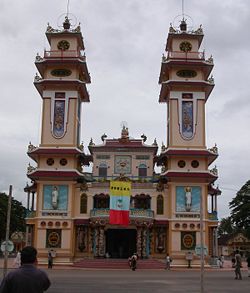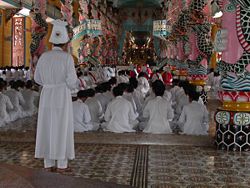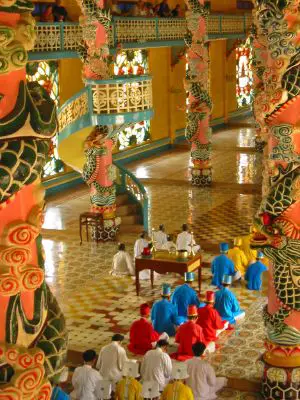Difference between revisions of "Cao Dai" - New World Encyclopedia
Scott Dunbar (talk | contribs) (Added categories) |
Scott Dunbar (talk | contribs) (Imported and credited from Wikipedia, and removed unneeded links) |
||
| Line 1: | Line 1: | ||
| + | {| style="float: right; margin: 5px;border:1px solid black" | ||
| + | |- | ||
| + | |style="text-align:center;padding-bottom: .40em; font-size: 210%" |Đạo Cao Đài | ||
| + | |- | ||
| + | |[[Chinese language|Chinese]]: 高台教 (''Gao-tai-jiao'') | ||
| + | |- | ||
| + | |[[English language|English]]: Caodaiism, Caodaism | ||
| + | |- | ||
| + | |[[Vietnamese language|Vietnamese]]: Đạo Cao Đài | ||
| + | |} | ||
| + | |||
| + | [[Image:Cao-dai-temple1.jpg|Tay Ninh Holy See|thumb|right|250px|Tay Ninh Holy See]] | ||
| + | |||
| + | '''Cao Dai''' (Cao Đài) is a relatively new, [[syncretism|syncretist]], [[monotheistic]] [[religion]], officially established in [[Tay Ninh|Tây Ninh]], southern [[Vietnam]], in [[1926]]. Đạo Cao Đài is the religion's shortened name, the full name is '''Đại Đạo Tam Kỳ Phổ Độ''' (Great Religion [of The] Third Period [of] Revelation [and] Salvation). | ||
| + | |||
| + | The term ''Cao Đài'' literally means "high place." Figuratively, it means that highest place where God reigns. It is also the abbreviated name for [[God]], the creator of the universe, whose full title is ''Cao Đài Tiên Ông Đại Bồ Tát Ma-ha-tát''. | ||
| + | |||
| + | Caodaiists credit God as the religion's founder. They believe the teachings, symbolism and organization were communicated directly from Đức (means Venerable) Cao Đài. Even the construction of the Tây Ninh [[Episcopal See|Holy See]] is claimed to have had divine guidance. | ||
| + | |||
| + | Cao Đài's first disciples [[Ngô Văn Chiêu]], Cao Quỳnh Cư, Phạm Công Tắc, and Cao Hoài Sang claimed to have received direct communications from God, who gave them explicit instructions for establishing a new religion that would commence the Third Era of Religious Amnesty. | ||
| + | |||
| + | Adherents engage in ethical practices such as [[prayer]], [[ancestor worship|veneration of ancestors]], [[nonviolence]], and [[vegetarianism]] with the minimum goal of rejoining God the Father in Heaven and the ultimate goal of freedom from [[reincarnation|the cycle of birth and death]]. | ||
| + | |||
| + | [[Image:Cao-dai-monks-and-priest.jpg|Cao Đài Ceremony|thumb|right|250px|Cao Đài Ceremony]] | ||
| + | |||
| + | Estimates of the number of Cao Đài adherents in Vietnam vary, but most sources give two to three million. Some estimates are as high as eight million adherents in Vietnam. An additional 30,000 (primarily ethnic Vietnamese) in the [[United States]], [[Europe]], and [[Australia]]. | ||
| + | |||
| + | ==Origin of God and the Universe== | ||
| + | Before God existed, there was the [[Tao]] — that nameless, formless, unchanging, eternal source referenced in the [[Tao Te Ching]]. At some point, a [[Big Bang]] occurred, out of which God was born. The universe could not yet be formed, for God controlled [[yin and yang|Yang]]. Therefore, He shed a part of himself and created the Goddess, master of [[yin and yang|Yin]]. In the presence of Yin and Yang, the universe materialized. The Goddess is, literally, the mother of the myriad of things in the Universe. Thus, Caodaiists not only worship God, the father, but also the Goddess, literally referred to as the Mother [[buddha|Buddha]]. Note that the Goddess, or Mother Buddha, is male, as are all Buddhas. The Goddess is master over Yin but is not a part of Yin, which is female. | ||
| + | |||
| + | There are 36 levels of [[heaven]] and 72 planets harboring intelligent life, with number one being the closest to heaven and 72 nearest to [[hell]]. Earth is number 68. It is said that even the lowest citizen on planet 67 would not trade place with a king on 68 and so forth. | ||
| + | |||
| + | ==Scriptures== | ||
| + | The Tây Ninh Holy See recognizes three main scriptures: | ||
| + | |||
| + | :1. Thánh Ngôn Hiệp Tuyển | ||
| + | :2. Pháp Chánh Truyền (The Religious Constitution of Caodaiism) | ||
| + | :3. Kinh Thiên Đạo Và Thế Đạo | ||
| + | |||
| + | ::Note: Scriptures from other sects will be listed later. | ||
| + | |||
| + | ==Symbolism== | ||
| + | God is symbolized by the [[Eye of Providence|Divine Eye]], specifically the left eye because Yang is the left side and God is the master of Yang. | ||
| + | |||
| + | ==The Three Teachings== | ||
| + | |||
| + | In the order of most to least difficult, the Three Teachings within Caodaiism are: | ||
| + | :The Teachings of Buddhas | ||
| + | :The Teachings of Sages | ||
| + | :The Teachings of Saints. | ||
| + | |||
| + | The Three Teachings represent levels of spiritual attainment, with Buddha as the highest. Caodaiism's various stages of spiritual development from human on up are: Thần (no translation yet) , Thánh (Saint), Tiên (Sage), and Phật (Buddha). | ||
| + | |||
| + | Thần, Saints and Sages may have, accordingly, long and extremely long life in the realms of heaven, but only Buddhas are free from the cycle of birth and death. | ||
| + | |||
| + | ==The Three Periods of Revelation and Salvation== | ||
| + | |||
| + | :First Period: | ||
| + | :1. The Teachings of Buddhas - [[Dipankara]] Buddha | ||
| + | :2. The Teachings of Sages - | ||
| + | :3. The Teachings of Saints - | ||
| + | |||
| + | :Second Period: | ||
| + | :1. The Teachings of Buddhas - [[Shakyamuni]] Buddha | ||
| + | :2. The Teachings of Sages - [[Lao Zi]] | ||
| + | :3. The Teachings of Saints - [[Confucius]] and [[Jesus]] | ||
| + | |||
| + | :Third Period: | ||
| + | :God is at the helm. | ||
| + | |||
| + | ::Note: Jesus is regarded as a Buddha and true son of God, shed directly from God. | ||
| + | |||
| + | ==Religious Constitution and Organization== | ||
| + | [[Image:Cao Dai temple (Vietnam).jpg|thumb|left|Cao Đài temple near [[Ho Chi Minh City|Hồ Chí Minh City]], Vietnam]] | ||
| + | Americans may be surprised to find that they are more familiar with Caodaiism's organizational structure than they realize. Caodaiism's governing body consists of three branches that are functionally equivalent to the U.S.'s [[legislature|legislative]], [[Executive (government)|executive ]] and [[Judiciary|judicial]] branches. | ||
| + | |||
| + | The head of the Executive Branch is called "Giáo Tông," which means leader or head of a philosophical or religious organization. Similarities between the hierarchy of Caodaiism's dignitaries and those of the [[Roman Catholic Church]] have led translators to borrow terminologies such as [[pope]], [[cardinal (Catholicism)|cardinals]], [[bishops]], [[priests]], etc. In practice, Caodaiism has more ranks and titles of which there are no official English translation as of yet. The actual Vietnamese term for Pope, as in the Catholic Pope, is "Giáo Hoàng." | ||
| + | |||
| + | Caodaiism stresses equality among men and women. However, the fact that ordained women may attain ranks only up to cardinal but not Pope may be misconstrued as unfair bias. The reason was explained by God when He established the church's hierarchical order. Yang represents male and Yin corresponds to female. Yin cannot rule over Yang or else chaos would occur. | ||
| + | |||
| + | ==Schism== | ||
| + | Caodaiism has also suffered from [[schism]]s like other religions. Some of the Cao Đài sects that have broken away from the Tây Ninh Holy See are Chiếu Minh, Bến Tre and Đà Nẵng. | ||
| + | |||
| + | Chiếu Minh - founded by Ngô Văn Chiêu. Mr. Chiêu refused his appointment as Caodaiism's first Pope and was neither involved in the religion's official establishment in 1926 nor the Tay Ninh Holy See. He accepted another entity as Đức Cao Đài and the Chiếu Minh sect of Caodaiism was formed. | ||
| + | |||
| + | ==Saints== | ||
| + | Although various sects of Caodaiism claim to have received messages from numerous spiritual entities, the Tây Ninh Holy See acknowledges significantly fewer. Inside the Holy See is a painting depicting the Three Saints [http://www.gluckman.com/caodai3.jpg] signing a covenant between God and mankind. From left to right, they are: [[Sun Yat Sen]], [[Victor Hugo]] and [[Nguyen Binh Khiem|Nguyễn Bỉnh Khiêm]]. | ||
| + | |||
| + | ==External links== | ||
| + | {{commons|Cao Đài }} | ||
| + | *[http://www.daocaodai.info Centre for Studies in Caodaiism, Sydney] | ||
| + | *[http://www.caodai.com Tam Kỳ Nguyên Nguyên Bản Bản] | ||
| + | *[http://www.caodai.net Cao Đài Overseas Missionary] | ||
| + | *[http://www.caodai.org Cao Đài site] | ||
| + | *[http://www.tuvy.com/Countries/vietnamese/people/cao_dai.htm Cao Đài ] | ||
| + | *[http://www.pbs.org/wnet/religionandethics/week644/feature.html PBS feature: Cao Đài] | ||
| + | *[http://www.gluckman.com/CaoDai.html Reporter Ron Gluckman's impression of Caodaiism] | ||
| + | |||
| + | [[Category:New religious movements]] | ||
| + | |||
| + | |||
[[Category:Philosophy and religion]][[Category:religion]] | [[Category:Philosophy and religion]][[Category:religion]] | ||
| + | |||
| + | {{Credit|49643671}} | ||
Revision as of 19:26, 23 April 2006
| Đạo Cao Đài |
| Chinese: 高台教 (Gao-tai-jiao) |
| English: Caodaiism, Caodaism |
| Vietnamese: Đạo Cao Đài |
Cao Dai (Cao Đài) is a relatively new, syncretist, monotheistic religion, officially established in Tây Ninh, southern Vietnam, in 1926. Đạo Cao Đài is the religion's shortened name, the full name is Đại Đạo Tam Kỳ Phổ Độ (Great Religion [of The] Third Period [of] Revelation [and] Salvation).
The term Cao Đài literally means "high place." Figuratively, it means that highest place where God reigns. It is also the abbreviated name for God, the creator of the universe, whose full title is Cao Đài Tiên Ông Đại Bồ Tát Ma-ha-tát.
Caodaiists credit God as the religion's founder. They believe the teachings, symbolism and organization were communicated directly from Đức (means Venerable) Cao Đài. Even the construction of the Tây Ninh Holy See is claimed to have had divine guidance.
Cao Đài's first disciples Ngô Văn Chiêu, Cao Quỳnh Cư, Phạm Công Tắc, and Cao Hoài Sang claimed to have received direct communications from God, who gave them explicit instructions for establishing a new religion that would commence the Third Era of Religious Amnesty.
Adherents engage in ethical practices such as prayer, veneration of ancestors, nonviolence, and vegetarianism with the minimum goal of rejoining God the Father in Heaven and the ultimate goal of freedom from the cycle of birth and death.
Estimates of the number of Cao Đài adherents in Vietnam vary, but most sources give two to three million. Some estimates are as high as eight million adherents in Vietnam. An additional 30,000 (primarily ethnic Vietnamese) in the United States, Europe, and Australia.
Origin of God and the Universe
Before God existed, there was the Tao — that nameless, formless, unchanging, eternal source referenced in the Tao Te Ching. At some point, a Big Bang occurred, out of which God was born. The universe could not yet be formed, for God controlled Yang. Therefore, He shed a part of himself and created the Goddess, master of Yin. In the presence of Yin and Yang, the universe materialized. The Goddess is, literally, the mother of the myriad of things in the Universe. Thus, Caodaiists not only worship God, the father, but also the Goddess, literally referred to as the Mother Buddha. Note that the Goddess, or Mother Buddha, is male, as are all Buddhas. The Goddess is master over Yin but is not a part of Yin, which is female.
There are 36 levels of heaven and 72 planets harboring intelligent life, with number one being the closest to heaven and 72 nearest to hell. Earth is number 68. It is said that even the lowest citizen on planet 67 would not trade place with a king on 68 and so forth.
Scriptures
The Tây Ninh Holy See recognizes three main scriptures:
- 1. Thánh Ngôn Hiệp Tuyển
- 2. Pháp Chánh Truyền (The Religious Constitution of Caodaiism)
- 3. Kinh Thiên Đạo Và Thế Đạo
- Note: Scriptures from other sects will be listed later.
Symbolism
God is symbolized by the Divine Eye, specifically the left eye because Yang is the left side and God is the master of Yang.
The Three Teachings
In the order of most to least difficult, the Three Teachings within Caodaiism are:
- The Teachings of Buddhas
- The Teachings of Sages
- The Teachings of Saints.
The Three Teachings represent levels of spiritual attainment, with Buddha as the highest. Caodaiism's various stages of spiritual development from human on up are: Thần (no translation yet) , Thánh (Saint), Tiên (Sage), and Phật (Buddha).
Thần, Saints and Sages may have, accordingly, long and extremely long life in the realms of heaven, but only Buddhas are free from the cycle of birth and death.
The Three Periods of Revelation and Salvation
- First Period:
- 1. The Teachings of Buddhas - Dipankara Buddha
- 2. The Teachings of Sages -
- 3. The Teachings of Saints -
- Second Period:
- 1. The Teachings of Buddhas - Shakyamuni Buddha
- 2. The Teachings of Sages - Lao Zi
- 3. The Teachings of Saints - Confucius and Jesus
- Third Period:
- God is at the helm.
- Note: Jesus is regarded as a Buddha and true son of God, shed directly from God.
Religious Constitution and Organization
Americans may be surprised to find that they are more familiar with Caodaiism's organizational structure than they realize. Caodaiism's governing body consists of three branches that are functionally equivalent to the U.S.'s legislative, executive and judicial branches.
The head of the Executive Branch is called "Giáo Tông," which means leader or head of a philosophical or religious organization. Similarities between the hierarchy of Caodaiism's dignitaries and those of the Roman Catholic Church have led translators to borrow terminologies such as pope, cardinals, bishops, priests, etc. In practice, Caodaiism has more ranks and titles of which there are no official English translation as of yet. The actual Vietnamese term for Pope, as in the Catholic Pope, is "Giáo Hoàng."
Caodaiism stresses equality among men and women. However, the fact that ordained women may attain ranks only up to cardinal but not Pope may be misconstrued as unfair bias. The reason was explained by God when He established the church's hierarchical order. Yang represents male and Yin corresponds to female. Yin cannot rule over Yang or else chaos would occur.
Schism
Caodaiism has also suffered from schisms like other religions. Some of the Cao Đài sects that have broken away from the Tây Ninh Holy See are Chiếu Minh, Bến Tre and Đà Nẵng.
Chiếu Minh - founded by Ngô Văn Chiêu. Mr. Chiêu refused his appointment as Caodaiism's first Pope and was neither involved in the religion's official establishment in 1926 nor the Tay Ninh Holy See. He accepted another entity as Đức Cao Đài and the Chiếu Minh sect of Caodaiism was formed.
Saints
Although various sects of Caodaiism claim to have received messages from numerous spiritual entities, the Tây Ninh Holy See acknowledges significantly fewer. Inside the Holy See is a painting depicting the Three Saints [1] signing a covenant between God and mankind. From left to right, they are: Sun Yat Sen, Victor Hugo and Nguyễn Bỉnh Khiêm.
External links
- Centre for Studies in Caodaiism, Sydney
- Tam Kỳ Nguyên Nguyên Bản Bản
- Cao Đài Overseas Missionary
- Cao Đài site
- Cao Đài
- PBS feature: Cao Đài
- Reporter Ron Gluckman's impression of Caodaiism
Credits
New World Encyclopedia writers and editors rewrote and completed the Wikipedia article in accordance with New World Encyclopedia standards. This article abides by terms of the Creative Commons CC-by-sa 3.0 License (CC-by-sa), which may be used and disseminated with proper attribution. Credit is due under the terms of this license that can reference both the New World Encyclopedia contributors and the selfless volunteer contributors of the Wikimedia Foundation. To cite this article click here for a list of acceptable citing formats.The history of earlier contributions by wikipedians is accessible to researchers here:
The history of this article since it was imported to New World Encyclopedia:
Note: Some restrictions may apply to use of individual images which are separately licensed.



